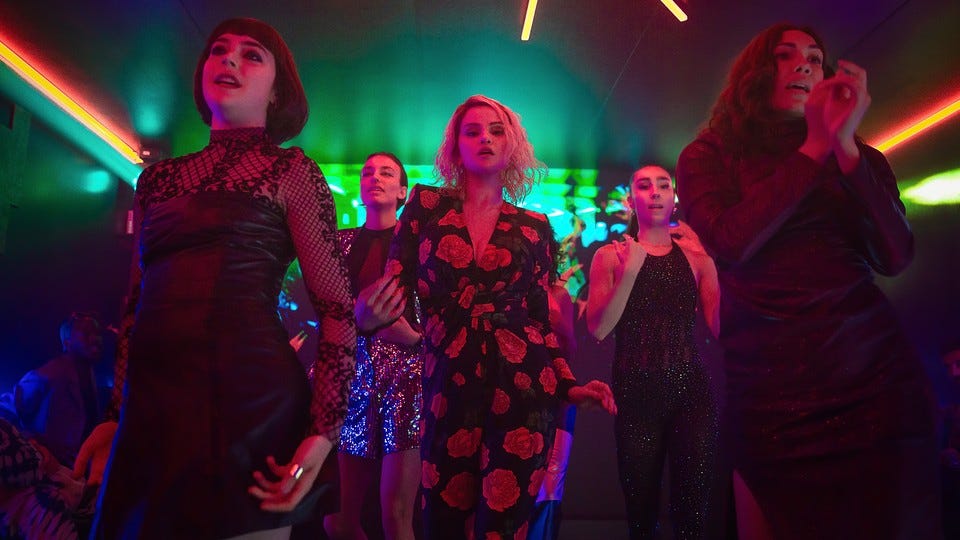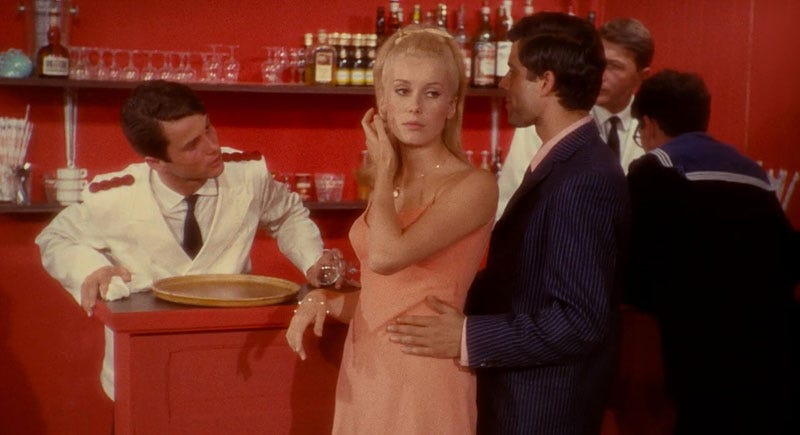Movies of the Month: December
A reminder to mark yourselves safe from Emilia Pérez (2024) this holiday season
Big month for musical movies! I lost two hours and ten minutes of my life to Emilia Pérez (2024), as well as enjoyed The Umbrellas of Cherbourg (1964) and A Complete Unknown (2024).
Let’s get into it:
Emilia Pérez (2024, dir. Jacques Audiard) — “Jacques Audiard took a big swing with Emilia Pérez (2024).” Okay?? So did Thomas Andrews when he designed the Titanic. And, yes, Zoe Saldaña and Karla Sofía Gascón give wonderful performances, but in the same way the band who played on the deck after the iceberg hit did.
A French-but-Mexico-set musical comedy crime thriller (yeah, you read that right), Emilia Pérez opens with overworked lawyer Rita Mora Castro (played by Saldaña) receiving an anonymous call from one of the country’s biggest cartel leaders, Juan “Manitas” del Monte (played by Gascón). In hopes of covertly undergoing gender-affirming surgery, Manitas employs Rita to help him find the best doctor and disappear. After a visit to Bangkok marked by a bizarre musical number, Rita finds the right surgeon in Tel Aviv (Per The Cut: “Bangkok’s reputation as a hub for transsexual medical tourism is as well established as it is easily Googleable; I couldn’t help but laugh when I realized that Emilia had paid someone millions of dollars to uncover this basic fact for her. Nor could I stifle my involuntary snorting at Audiard’s portrayal of a surgery consult, which involved a surgeon simply naming procedures and Rita saying ‘Yes!’ to each one.”). Manitas fakes his death; sets his wife, Jessi (played by Selena Gomez), and kids up in Switzerland; and sends Rita off to London with a large sum of money, embarking on a new life as Emilia Pérez.
Four years later, Rita meets Emilia in London, quickly discerning her former identity. Emilia asks for help reuniting with her children, launching a telenovela-esque reunion that puts Jessi and their kids back in Mexico City alongside “Aunt” Emilia. In search of redemption, Emilia simultaneously launches a nonprofit to help families reunite with “desaparecidos,” or people presumed dead at the hands of the cartel violence she once incited, alongside Rita. Meanwhile, Jessi rekindles her relationship with Gustavo (played by Édgar Ramírez), the object of her affection during her marriage to Manitas, stoking jealousy in Emilia as the movie limps, then barrels, toward its conclusion. (If you feel like you just came off an acid trip after reading that, imagine actually watching the movie.)
Structurally, Emilia Pérez bears similarities to Mary Gaitskill’s The Devil’s Treasure: A Book of Stories and Dreams (2021). As I discuss in the June Book Review, the book “serves as equal parts short story, literary criticism, and anthology. In it, Gaitskill aggregates snippets from her various novels and writings over the years — from Two Girls, Fat and Thin (1998) to Veronica (2005) to The Mare (2015) — and analyzes her influences with the gift of hindsight. She simultaneously pens a new short story about a little girl in search of treasure that dovetails with her chosen cuts.” Both Emilia Pérez and The Devil’s Treasure extract elements from various genres, bleeding each one of its depth in the process. The film and novel emerge as everything and nothing.
On a tonal level, both Gaitskill and Audiard explore cultures and perspectives beyond their own — with limited nuance. In her 2019 essay for The New York Review, “Fascinated to Presume: In Defense of Fiction,” Zadie Smith discusses the question of who has the right to tell others’ stories, writing: “Is this novel before me an attempt at compassion or an act of containment? Each reader will decide. This is the work of an individual consciousness and cannot be delegated to generalized arguments, not even the prepackaged mental container of ‘cultural appropriation.’” I frequently use Smith’s piece as a framework for evaluating film and fiction. In my review of The Devil’s Treasure, I write:
Gaitskill reveals that she based Velvet [Vargas, a Dominican girl who operates as the main character in The Mare] on a young woman whose emotional life she knew quite well. That said, she had limited optics into how this teenager interacted with her mother. Nonetheless, without interviews or research, Gaitskill writes from the perspective of Velvet’s mother, relying on feeling alone to sustain her work. As a result, I would classify The Mare’s narrative as what Smith calls “an act of containment,” “an attempt at compassion” gone wrong, sloppily spurred by her faulty assumption of “awkwardness” as “inevitable.” Gaitskill’s persistent defense of it, to me, weakens The Devil’s Treasure, dilutes the potent self-reflection that shapes its earlier passages.
Similarly to Gaitskill, Audiard, a Frenchman through and through, animates a version of Mexico rooted in admiration and stylization rather than research (Audiard: “No, I didn’t study much, I kind of already knew what I wanted to understand.”). Per The New York Times, Audiard “doesn’t often enjoy musicals and doesn’t speak Spanish…He lifted his protagonist from the pages of Boris Razon’s 2018 novel, Écoute, about our hyperconnected, perpetually online world. One chapter features a ruthless Mexican cartel boss seeking a gender transition who hires a lawyer to help with the logistics.” The film crew includes people who possess a deep understanding of the language and the culture that shape the film; for instance, French songwriter Camille partnered with Mexican translator Karla Aviles on the film’s lyrics. But the creators at its core approach the narrative from the outside (Audiard: “Throughout the shoot we had problems, for instance, with Selena’s accent in Spanish. She is Texan. Karla Sofía Gascón speaks Castilian Spanish. She’s from Madrid. Given that I don’t speak Spanish, the nuances of the Mexican accent versus the Castilian were lost on me.”). As a result, I would deem Emilia Pérez what Smith calls an “act of containment” and a lazy one at that, a poorly-executed pastiche shot in a Paris studio.
Audiard’s emphasis on stylization over substance bleeds over to his portrayal of Emilia herself as well. To close, I’ll echo certain excerpts from award-winning trans journalist Harron Walker’s review of the film for The Cut. She writes:
I don’t demand total realism from every film that I see. I can even appreciate the camp, whether intentional or not, of Emilia waking up from her 5-million simultaneous surgeries, her face bandaged like a mummy save for her eyes and lips. But I expect that a filmmaker so taken by the concept of transitioning, one who’s displayed a certain level of conscious sensitivity in his previous efforts to depict lives unlike his own, to at least display an informed understanding of what that concept actually looks like in practice.
On the one hand…[Emilia Pérez] affirms Emilia’s claim to womanhood, to a ridiculous degree at times…On the other, it presents Emilia as a nesting doll of gendered selves…This emerges most revoltingly during a scene in which Emilia grows upset with her unsuspecting widow, played by Gomez, and responds by throwing her onto a bed and choking her, while threatening her in a low, masculine voice — the same voice with which she spoke before she surgically transitioned.
Overall, though, the film presents transition as inherently redemptive. In Emilia’s case, she not only transitions from male to female…She also transitions from a cartel leader responsible for the deaths of untold thousands to the founder of a nonprofit that seeks to assist the families of victims of cartel violence…Gascón gives an incredible performance, as do all of her co-stars, but I loathed her character, largely because I sensed that the film wanted me to like her, to root for her transition from an evil rich man to an evil rich woman, to celebrate her solely for the fact of her transition…[Audiard is] so focused on wanting to humanize her — in patronizing, at times insulting terms — that her humanity is sacrificed in the process.
Where to Watch: ~a theater near you~, Netflix (subscription)
The Umbrellas of Cherbourg (1964, dir. Jacques Demy) — The infinitely superior French-produced movie musical I saw in December! Filmmaker Jacques Demy animates a candy-colored world, the film’s bright sets and costumes masquerading the melancholic message at its core.
Winner of the Palme d'Or, The Umbrellas of Cherbourg (1964) centers on a pair of young lovers residing in the rural French town of Cherbourg. 17-year-old Geneviève (played by Catherine Deneuve) works alongside her mother, Madame Émery (played by Anne Vernon), at their struggling umbrella boutique, while Guy (played by Nino Castelnuovo), an auto mechanic, cares for his sickly aunt and godmother, Élise (played by Mireille Perrey). Geneviève and Guy spend their evenings exploring the town, fantasizing about a life together, a marriage, despite her mother’s protestations. But before they can exchange vows, Guy gets drafted to Algeria, leading to a separation that draws into question the longevity of first love.
The plot has the potential to edge into melodrama, but Deneuve and Castelnuovo ground the film, as does Demy’s downbeat, reflective ending. As Roger Ebert writes in his 2004 review, The Umbrellas of Cherbourg “was a curious experiment in which all of the words were sung; Michel Legrand wrote the wall-to-wall score, which includes not only the famous main theme and other songs, but also Demy’s sung dialogue, in the style of the lines used to link passages in opera. This style would seem to suggest a work of featherweight romanticism, but Umbrellas is unexpectedly sad and wise, a bittersweet reflection on the way true love sometimes does not (and perhaps should not) conquer all.”
Where to Watch: Max (subscription), Amazon Prime Video (premium subscription)
A Complete Unknown (2024, dir. James Mangold) — I love Bob Dylan, and I love Timothée Chalamet, so, naturally, I adored this movie.
From the filmmaker behind Walk the Line (2005), A Complete Unknown (2024) opens with 19-year-old Bob Dylan (played by Chalamet) arriving in New York to bid farewell to one of his heroes, hospitalized folk star Woody Guthrie (played by Scoot McNairy). The film then traces Dylan’s rise to fame within the confines of the folk community, followed by his rejection of it at the 1965 Newport Folk Festival, where he famously went electric. It simultaneously reanimates his relationships with Suze Rotolo, renamed Sylvie Russo at Dylan’s behest (played by Elle Fanning), and Joan Baez (played by Monica Barbaro).
In the film, Dylan tells Sylvie: “If anyone is gonna hold your attention on a stage, you have to kind of be a freak…You can be beautiful or you can be ugly, but you can’t be plain.” Chalamet takes this principle to heart. He accentuates the idiosyncrasies that define Dylan without strapping into the straightjacket of imitation; he embodies the seminal artist’s singing and speaking voices, as well as his mannerisms, while still bringing freedom and flexibility to his performance. As James T. Keane writes in his piece, “A Bob Dylan Nerd Reviews A Complete Unknown” (lol), “Chalamet captures well the Dylan of that period: alternately charming and vicious, Everyman but then Mephisto.”
Some Dylan purists — including Richard Brody at The New Yorker — take issue with aspects of the film, namely its liberties with the timeline and specifics of Dylan’s life. Brody laments Mangold’s failure to show “how a young musician without a day job finds a place to live in the Village,” writing: “The movie offers answers that range from empty to artificial, leaving out the practicalities and manipulating dates and names in order to center the drama on a small number of personalities.” From my perspective, these points hardly matter. A Complete Unknown concerns itself with distilling the emotional truth of Dylan’s early artistry. By focusing on a smaller cast of characters — rather than burning screen time explaining Dylan’s leasing process or introducing a laundry list of personalities —, Mangold imbues those people who do appear with enhanced symbolic significance, conveying deeper truths about Dylan ca. 1965.
Yes, Dylan and Rotolo — Sylvie’s real-life basis — had broken up prior to the 1965 Newport Folk Festival. (Brody decries: “What the documentary understandably leaves out but the bio-pic incomprehensibly omits is that, at the time, Bob was already involved with another woman, Sara Lownds, whom he’d marry later that same year.”) But, in the context of A Complete Unknown, Sylvie’s presence at the event serves an emblematic purpose. Mangold presents the 1965 Newport Folk Festival as a liminal moment for Dylan, a personal, artistic, and cultural delineation between past and present. As Dylan parts ways with Sylvie on the eve of this artistic watershed, Mangold deepens the notion of this performance as an individual and cultural rebirth.
Where to Watch: ~a theater near you~
Okay, that’s all for now! Stay tuned for favorite books and movies of 2024 in the January newsletter.
xo,
Najet








